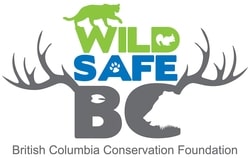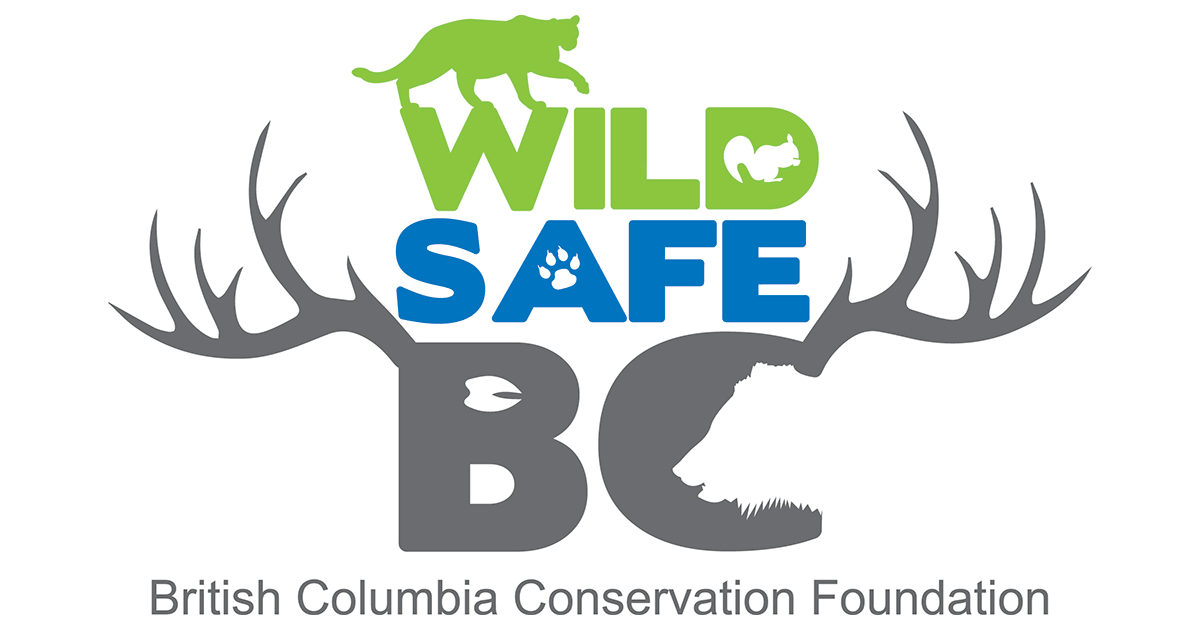Skunk
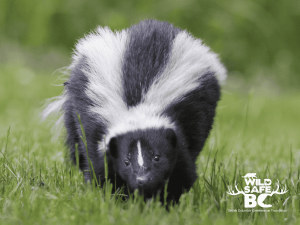 Skunk Snapshot
Skunk Snapshot
There are two species of skunk in British Columbia: the Striped Skunk (Mephitis mephitis), which can be found throughout much of the province and the less common Western Spotted Skunk (Spilogale gracilis) which is found in the Lower Mainland. These small omnivorous mammals are highly adaptive and easily habituated to living near humans, enabling them to thrive in urban and suburban areas.
Infamous for their distinctive smell, skunks spray a pungent liquid into the face of potential predators as an effective defense mechanism. The spray from a skunk, while foul smelling, is not a vector for transmitting disease. Human-skunk conflicts can occur when they damage lawns digging for grubs, interact with pets or when they seek shelter under buildings.
Skunks are native to BC and are protected under the BC Wildlife Act. While trapping and relocating skunks without a permit is allowed if they are causing damage on a person’s property, it can be challenging to do so humanely and safely. WildSafeBC recommends exploring other options under “Conflict Reduction” that may have longer lasting results. If removal is necessary, consider contacting a qualified and reputable pest management contractor.
Wild Skunk Facts
- There are two types of skunks in BC: striped skunks and spotted skunks
- Skunks are well known for their strong musk that they can spray up to 6 m
- While skunks are not true hibernators, they will retreat to dens over the winter
- As many as 20 skunks have been reported sharing the same den
- Skunks are most active at dawn and dusk (crepuscular)
- Skunks are omnivores and will eat a varied diet
- Striped skunks are not skilled climbers but spotted skunks are
- Spotted skunks may perform a handstand as a form of intimidation but they do not spray in this position
- Skunks are short-lived, managing only two to three years in the wild; spotted skunks even less
- While skunks can be vectors for rabies, there are currently no confirmed records in BC
- Because of their voracious appetite for insects and rodents, they can provide an effective form of pest control in agricultural areas.
Identification
Striped skunks are house-cat sized mammals that are easily identified by their two white stripes that run along their black body. They measure 50 to 72 cm from nose to tail and weigh between 2 to 3.5 kg. Females tend to be 10 percent smaller than males.
The spotted skunk is about half the size of a striped skunk with a combination of vertical stripes and spots as well as a bushy white-tipped tail. Once thought to be part of the weasel family, they are now classified under Mephitidae.
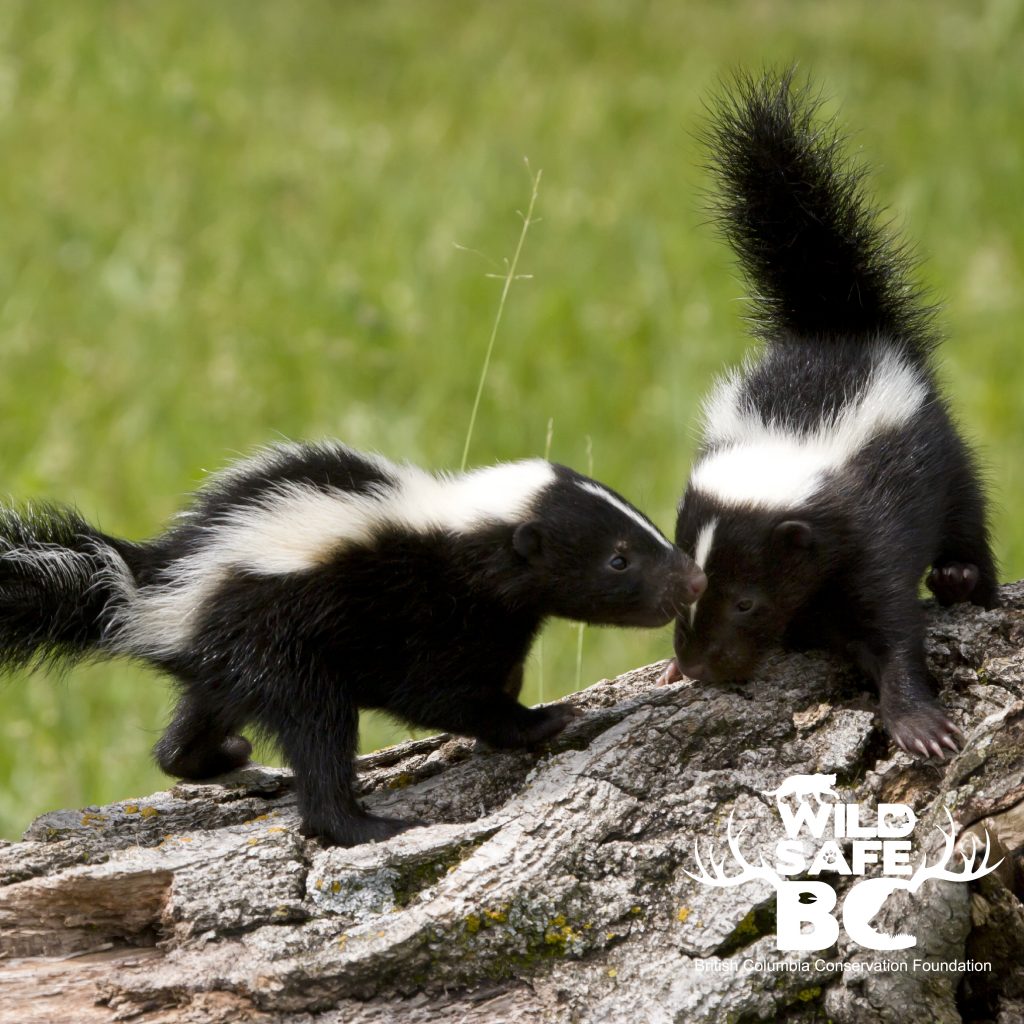
Biology
After breeding in the late winter or early spring months, females give birth to litters of four to seven young called kits in early May. The kits are born blind and nearly hairless. After three weeks they will gain sight and after another five weeks, they may begin to leave the den. Young skunks will disperse and leave the family unit in the fall and become sexually mature at one year of age. Typically skunks are short-lived animals, managing only two to three years in the wild but up to 10 years in captivity.
Skunks are opportunistic omnivores that will feed on a varied diet of insects and their larvae, frogs, small mammals, eggs, plants, berries and carrion. They have long, sharp claws on their front feet which serve as effective tools for digging for mice, grubs and other underground prey. Striped skunks are not adept climbers and their eyesight is poor.
Skunks have musk glands near the anus for marking their territory. Skunks are unique in that they can spray this musk when threatened to a distance of up to 6 m. Skunks reserve this effective defense mechanism as a last resort as it takes over a week for the musk to be replenished once discharged.
Skunks have few predators except for hawks, owls and occasionally coyotes, foxes, wolves or wild felines that are desperate for a meal.
Behaviour
Skunks are crepuscular which means they are most active at dawn and dusk and spend the daytime hours in underground burrows. Skunks spend the winter months in deep underground dens in a state of inactivity. While solitary for the rest of the year, skunks may den in groups of up to twenty individuals. Skunks rarely dig their own burrows, preferring to use abandoned dens of other animals, or by finding crevices and gaps under porches or buildings. Their den system may consist of a series of tunnels and chambers with more than one entrance.
Prior to using their spray, skunks that feel threatened may hiss, growl or stamp their feet. Spotted skunks have been observed doing handstands.
Range and Habitat
Striped skunks are found throughout most of British Columbia except for Vancouver Island, Haida Gwaii and other coastal islands. The spotted skunk in limited to the Lower Mainland. Skunks tend to forage within 800 m of their den but may venture as far as 2 km.
Skunks can be found in a wide range of habitats, but prefer open areas and forest edges. They are well-adapted to living in urban environments.
Skunk Safety
Skunks are timid animals and are not often seen during the day. If you happen to encounter a skunk at close range, conflict can be avoided by calmly giving the animal a wide berth. Keep pets on a leash and do not allow them to provoke a skunk.
When threatened, a skunk may stomp its feet and hiss but will only spray as a last resort. An indicator that a skunk is about to spray is when the animal bends its body into a “U”shape, with both its face and raised tail facing its target.
The spray from a skunk, while foul smelling, is not a vector for transmitting disease. A solution of hydrogen peroxide, baking soda and dish soap can help neutralize the smell.
While skunks are not known to be carriers of rabies in BC, they can transmit distemper to your pet if bitten or scratched. Also, if travelling, be aware that skunks do carry rabies in other parts of North America. If your pet receives a scratch or bite from a skunk, take it to a veterinarian.
If you are bitten or scratched by an animal you think may have rabies, wash the wound with soap and water and then seek medical attention immediately. For more information on rabies visit:
http://www.bccdc.ca/health-info/diseases-conditions/rabies
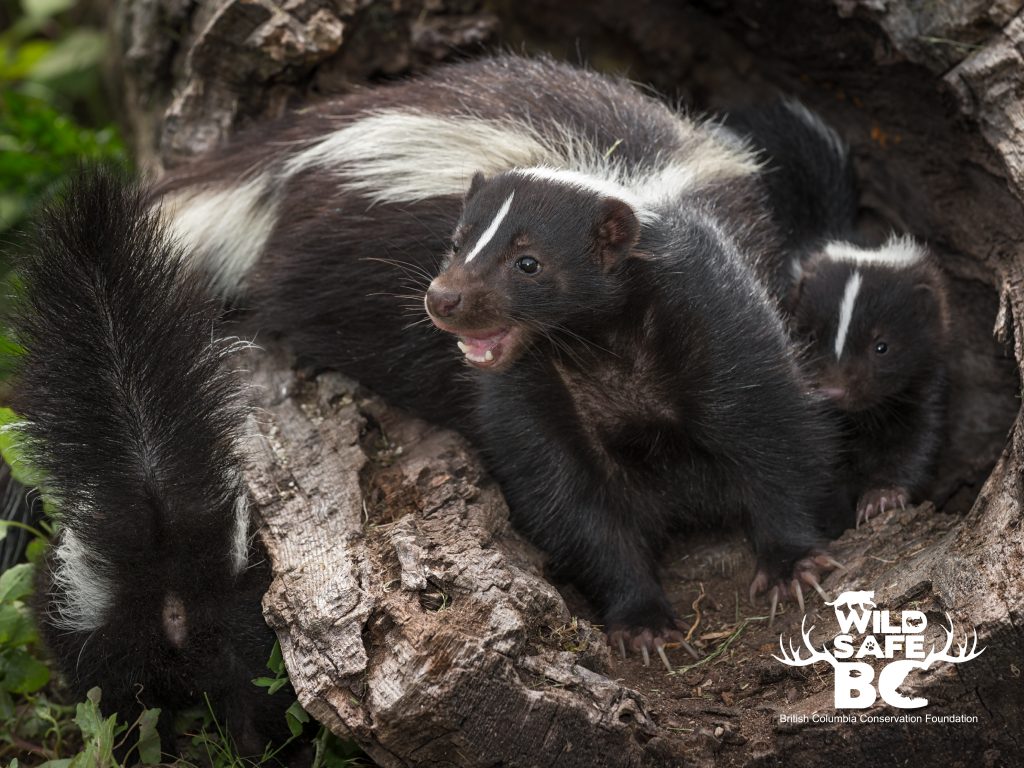
Conflict Reduction with Skunks
Skunks are typically shy, timid animals, but given their tendency to live in urban and suburban settings, they can sometimes come into conflict with humans. Skunks can thrive in backyards and farm fields, sleeping away the daylight hours under a porch or shed and coming out in the evenings to forage. They can be effective rodent control but they may also damage lawns as they dig up insects and worms. Being opportunistic omnivores, skunks can also be attracted into yards by things like unsecured garbage, fallen birdseed, windfall fruit and pet food.
While skunks can become quite comfortable around humans, if cornered, startled or threatened by humans or their pets, skunks may spray their pungent musk as a defense. As anyone who has experienced this knows, this pungent spray is very difficult to get rid of, whether on your dog, your clothing or even just lingering in the air! Because of this, people are often hesitant to have skunks living in their yard.
Skunks are native to BC and protected under the BC Wildlife Act. Skunks fall under Schedule B which permits a property owner, or an agent working with their permission, to remove skunks from their property without a permit if they are causing damage. However, removal is usually only a short-term solution and skunks or other wildlife will re-occupy the site if it is still suitable habitat. If removal of skunks is considered necessary, we recommend hiring a qualified and reputable "pest management" contractor. Before considering removing skunks from your property it is best to explore other options first such as the ones provided below.
Secure Attractants
- Keep all garbage securely stored until the day of collection. Keeping garbage securely stored indoors will keep it inaccessible to all the wildlife in your neighbourhood. Ensure bins are tightly closed.
- Regularly wash all recycling items and clean the bins that contain garbage, recycling or compost.
- If you must store garbage outside, freeze smelly items until collection day and then add them when you put your cart out for collection.
- Manage your fruit trees and berry bushes by picking all fruit as it ripens. Ensure windfalls do not accumulate below the trees or shrubs.
- Take bird feeders down until winter to avoid attracting unwanted visitors. Store all feed indoors. When bird feeders are up, ensure fallen seed does not accumulate below the feeders.
- Feed pets indoors. Store all food securely inside.
- Never intentionally feed skunks.
- Keep all small livestock in a secure enclosure at night.
- Use a properly maintained electric fence if you keep chickens, bees or small livestock.
Change the quality of the habitat
- Remove brush and wood piles and keep grasses mowed.
- Encourage skunks to move out of a den by placing a bright light or radio in or near the den site.
- Motion-activated lights, sprinklers or even radios may help deter skunks from foraging in gardens, lawns and orchards.
Prevent access to your home and outbuildings
Seal up any holes or potential entrances around the exterior of your house and other buildings. You can use wire mesh. Since skunks are excellent diggers, you may need to extend the wire underground.
Exclusion should not be attempted between May and August to avoid separating family units that may already be inside.
If you want to exclude a skunk from an occupied den, it is best to do so after dark when you know the skunk has left. Alternatively, you can fix a hinged piece of mesh wire over the entrance that an animal can push to get out of the den, but cannot get back in. Keep in mind there is usually more than one entrance to a den.
Skunk Resources
 Skunk Snapshot
Skunk Snapshot
There are two species of skunk in British Columbia: the Striped Skunk (Mephitis mephitis), which can be found throughout much of the province and the less common Western Spotted Skunk (Spilogale gracilis) which is found in the Lower Mainland. These small omnivorous mammals are highly adaptive and easily habituated to living near humans, enabling them to thrive in urban and suburban areas.
Infamous for their distinctive smell, skunks spray a pungent liquid into the face of potential predators as an effective defense mechanism. The spray from a skunk, while foul smelling, is not a vector for transmitting disease. Human-skunk conflicts can occur when they damage lawns digging for grubs, interact with pets or when they seek shelter under buildings.
Skunks are native to BC and are protected under the BC Wildlife Act. While trapping and relocating skunks without a permit is allowed if they are causing damage on a person’s property, it can be challenging to do so humanely and safely. WildSafeBC recommends exploring other options under “Conflict Reduction” that may have longer lasting results. If removal is necessary, consider contacting a qualified and reputable pest management contractor.
Wild Skunk Facts
- There are two types of skunks in BC: striped skunks and spotted skunks
- Skunks are well known for their strong musk that they can spray up to 6 m
- While skunks are not true hibernators, they will retreat to dens over the winter
- As many as 20 skunks have been reported sharing the same den
- Skunks are most active at dawn and dusk (crepuscular)
- Skunks are omnivores and will eat a varied diet
- Striped skunks are not skilled climbers but spotted skunks are
- Spotted skunks may perform a handstand as a form of intimidation but they do not spray in this position
- Skunks are short-lived, managing only two to three years in the wild; spotted skunks even less
- While skunks can be vectors for rabies, there are currently no confirmed records in BC
- Because of their voracious appetite for insects and rodents, they can provide an effective form of pest control in agricultural areas.
Identification
Striped skunks are house-cat sized mammals that are easily identified by their two white stripes that run along their black body. They measure 50 to 72 cm from nose to tail and weigh between 2 to 3.5 kg. Females tend to be 10 percent smaller than males.
The spotted skunk is about half the size of a striped skunk with a combination of vertical stripes and spots as well as a bushy white-tipped tail. Once thought to be part of the weasel family, they are now classified under Mephitidae.

Biology
After breeding in the late winter or early spring months, females give birth to litters of four to seven young called kits in early May. The kits are born blind and nearly hairless. After three weeks they will gain sight and after another five weeks, they may begin to leave the den. Young skunks will disperse and leave the family unit in the fall and become sexually mature at one year of age. Typically skunks are short-lived animals, managing only two to three years in the wild but up to 10 years in captivity.
Skunks are opportunistic omnivores that will feed on a varied diet of insects and their larvae, frogs, small mammals, eggs, plants, berries and carrion. They have long, sharp claws on their front feet which serve as effective tools for digging for mice, grubs and other underground prey. Striped skunks are not adept climbers and their eyesight is poor.
Skunks have musk glands near the anus for marking their territory. Skunks are unique in that they can spray this musk when threatened to a distance of up to 6 m. Skunks reserve this effective defense mechanism as a last resort as it takes over a week for the musk to be replenished once discharged.
Skunks have few predators except for hawks, owls and occasionally coyotes, foxes, wolves or wild felines that are desperate for a meal.
Behaviour
Skunks are crepuscular which means they are most active at dawn and dusk and spend the daytime hours in underground burrows. Skunks spend the winter months in deep underground dens in a state of inactivity. While solitary for the rest of the year, skunks may den in groups of up to twenty individuals. Skunks rarely dig their own burrows, preferring to use abandoned dens of other animals, or by finding crevices and gaps under porches or buildings. Their den system may consist of a series of tunnels and chambers with more than one entrance.
Prior to using their spray, skunks that feel threatened may hiss, growl or stamp their feet. Spotted skunks have been observed doing handstands.
Range and Habitat
Striped skunks are found throughout most of British Columbia except for Vancouver Island, Haida Gwaii and other coastal islands. The spotted skunk in limited to the Lower Mainland. Skunks tend to forage within 800 m of their den but may venture as far as 2 km.
Skunks can be found in a wide range of habitats, but prefer open areas and forest edges. They are well-adapted to living in urban environments.
Skunk Safety
Skunks are timid animals and are not often seen during the day. If you happen to encounter a skunk at close range, conflict can be avoided by calmly giving the animal a wide berth. Keep pets on a leash and do not allow them to provoke a skunk.
When threatened, a skunk may stomp its feet and hiss but will only spray as a last resort. An indicator that a skunk is about to spray is when the animal bends its body into a “U”shape, with both its face and raised tail facing its target.
The spray from a skunk, while foul smelling, is not a vector for transmitting disease. A solution of hydrogen peroxide, baking soda and dish soap can help neutralize the smell.
While skunks are not known to be carriers of rabies in BC, they can transmit distemper to your pet if bitten or scratched. Also, if travelling, be aware that skunks do carry rabies in other parts of North America. If your pet receives a scratch or bite from a skunk, take it to a veterinarian.
If you are bitten or scratched by an animal you think may have rabies, wash the wound with soap and water and then seek medical attention immediately. For more information on rabies visit:
http://www.bccdc.ca/health-info/diseases-conditions/rabies

Conflict Reduction with Skunks
Skunks are typically shy, timid animals, but given their tendency to live in urban and suburban settings, they can sometimes come into conflict with humans. Skunks can thrive in backyards and farm fields, sleeping away the daylight hours under a porch or shed and coming out in the evenings to forage. They can be effective rodent control but they may also damage lawns as they dig up insects and worms. Being opportunistic omnivores, skunks can also be attracted into yards by things like unsecured garbage, fallen birdseed, windfall fruit and pet food.
While skunks can become quite comfortable around humans, if cornered, startled or threatened by humans or their pets, skunks may spray their pungent musk as a defense. As anyone who has experienced this knows, this pungent spray is very difficult to get rid of, whether on your dog, your clothing or even just lingering in the air! Because of this, people are often hesitant to have skunks living in their yard.
Skunks are native to BC and protected under the BC Wildlife Act. Skunks fall under Schedule B which permits a property owner, or an agent working with their permission, to remove skunks from their property without a permit if they are causing damage. However, removal is usually only a short-term solution and skunks or other wildlife will re-occupy the site if it is still suitable habitat. If removal of skunks is considered necessary, we recommend hiring a qualified and reputable "pest management" contractor. Before considering removing skunks from your property it is best to explore other options first such as the ones provided below.
Secure Attractants
- Keep all garbage securely stored until the day of collection. Keeping garbage securely stored indoors will keep it inaccessible to all the wildlife in your neighbourhood. Ensure bins are tightly closed.
- Regularly wash all recycling items and clean the bins that contain garbage, recycling or compost.
- If you must store garbage outside, freeze smelly items until collection day and then add them when you put your cart out for collection.
- Manage your fruit trees and berry bushes by picking all fruit as it ripens. Ensure windfalls do not accumulate below the trees or shrubs.
- Take bird feeders down until winter to avoid attracting unwanted visitors. Store all feed indoors. When bird feeders are up, ensure fallen seed does not accumulate below the feeders.
- Feed pets indoors. Store all food securely inside.
- Never intentionally feed skunks.
- Keep all small livestock in a secure enclosure at night.
- Use a properly maintained electric fence if you keep chickens, bees or small livestock.
Change the quality of the habitat
- Remove brush and wood piles and keep grasses mowed.
- Encourage skunks to move out of a den by placing a bright light or radio in or near the den site.
- Motion-activated lights, sprinklers or even radios may help deter skunks from foraging in gardens, lawns and orchards.
Prevent access to your home and outbuildings
Seal up any holes or potential entrances around the exterior of your house and other buildings. You can use wire mesh. Since skunks are excellent diggers, you may need to extend the wire underground.
Exclusion should not be attempted between May and August to avoid separating family units that may already be inside.
If you want to exclude a skunk from an occupied den, it is best to do so after dark when you know the skunk has left. Alternatively, you can fix a hinged piece of mesh wire over the entrance that an animal can push to get out of the den, but cannot get back in. Keep in mind there is usually more than one entrance to a den.
